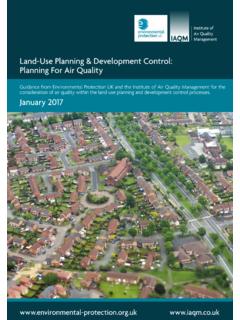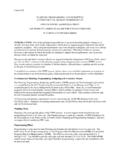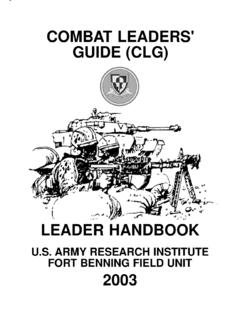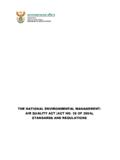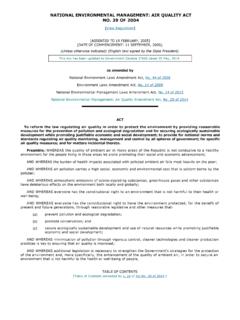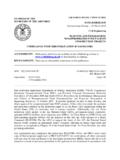Transcription of BY ORDER OF THE AIR FORCE PAMPHLET 23-221 …
1 BY ORDER OF THE AIR FORCE PAMPHLET 23-221 . SECRETARY OF THE AIR FORCE . 11 MARCH 2013. materiel management FUELS logistics planning . COMPLIANCE WITH THIS PUBLICATION IS MANDATORY. ACCESSIBILITY: Publications and forms are available on the e-publishing website at for downloading or ordering. RELEASABILITY: There are no releasability restrictions on this publication. OPR: AF/A4LE Certified by: AF/A4L. (Maj Gen John B. Cooper). Supersedes: AFPAM23-221, Pages: 102. 22 December 2006. This PAMPHLET establishes basic guidance for planning and executing fuel support operations, particularly at other than main operating bases.
2 It implements Air FORCE Policy Directive (AFPD) 23-2, management of Bulk Petroleum and Related Products. It identifies logistics planning factors and guidance on fuel -related products, equipment, and support procedures. This PAMPHLET applies to all Air FORCE activities involved in fuel support operations, including the US. Air FORCE Reserve and the Air National Guard. Refer recommended changes and questions about this publication to the Office of Primary Responsibility (OPR) using the AF Form 847, Recommendation for Change of Publication; route AF Form 847s from the field through the appropriate functional chain of command.
3 This publication may be supplemented at any level, but all direct Supplements must be routed to the OPR of this publication prior to certification and approval. The use of any specific manufacturer name, commercial product, commodity, or service in this publication does not imply endorsement by the Air FORCE . Ensure that all records created as a result of processes prescribed in this publication are maintained in accordance with (IAW) Air FORCE Manual (AFMAN) 33-363, management of Records, and disposed of IAW Air FORCE Records Information management System (AFRIMS) Records Disposition Schedule (RDS) located at SUMMARY OF CHANGES.
4 This is the fourth revision of AFPAM 23-221 . Major changes to this document include handling guidance for Aviation Gasoline (AVGAS), the aircraft planning factor table, the link to the Unit Type Code (UTC) Mission Capability (MISCAP) statements, cryogenic requirements determination, updated decision logic table, and Fuels Support Equipment (FSE) Program 2 AFPAM23-221 11 MARCH 2013. management Structure and Responsibilities. This publication must be reviewed in its entirety due to these major revisions. Chapter 1 GENERAL INFORMATION ABOUT THIS PAMPHLET AND FUELS 5. Purpose of this PAMPHLET .. 5.
5 Basic Fuels logistics planning .. 5. Chapter 2 FUNCTIONS AND RESPONSIBILITIES 6. Major Command (MAJCOM) Fuels.. 6. The Combatant Commander (CCDR).. 6. DLA Energy.. 6. logistics Readiness Squadron (LRS).. 6. Air FORCE Petroleum Agency (AFPA).. 6. Fuels management Team (FMT).. 7. Refueling Maintenance.. 7. Civil Engineers.. 8. Airfield management .. 8. Chapter 3 AIRFIELD SUPPORT 9. Airfield Surveys.. 9. Host Nation Support.. 9. Memorandum of Agreement (MOA).. 9. fuel Availability.. 9. Quality Control.. 10. Chapter 4 fuel SUPPORT 11. Computing Requirements.. 11. Resupply Options.. 12. Aircraft Systems.
6 13. Storage Options.. 13. Additives.. 14. Ground Fuels.. 14. Personnel and Equipment Requirements.. 15. Chapter 5 FUELS EQUIPMENT INTEROPERABILITY 16. Dispensing Options.. 16. Joint Interoperability.. 16. AFPAM23-221 11 MARCH 2013 3. Nonstandard Refueling Operations.. 16. Couplings, Nozzles, and Adaptors.. 17. Chapter 6 CRYOGENICS 18. Availability.. 18. Storage.. 18. Issue.. 18. Requirements.. 18. Chapter 7 SPECIAL FUELS 19. Thermally Stable Jet fuel (JPTS).. 19. Aviation Gasoline (AVGAS).. 19. Chapter 8 ADMINISTRATION AND ACCOUNTING 20. Reporting.. 20. Security.. 20. Communications.. 20. Transportation.
7 20. Accounting.. 20. Deployed fuel Dispensing Vehicle/Equipment Deficiency Reporting.. 20. Chapter 9 PERSONNEL 22. Responsibilities.. 22. management .. 22. Morale and Welfare.. 22. Host Nation Relations.. 22. Chapter 10 FUELS FORCE MODULES (IAW AFI 10-401) 23. The AETF FORCE modules.. 23. AEF Sourcing Plans and Tasks Timeline.. 23. AEF Schedule Preparation Timeline.. 23. Attachment 1 GLOSSARY OF REFERENCES AND SUPPORTING INFORMATION 25. Attachment 2 FUELS logistics planning GUIDANCE CONSIDERATIONS 36. Attachment 3 AIRFIELD FUELS SITE SURVEY 41. Attachment 4 PRODUCT SPECIFICATIONS AND TYPICAL PROPERTIES 46.
8 Attachment 5 SUPPORT PACKAGES 51. 4 AFPAM23-221 11 MARCH 2013. Attachment 6 CONVERSION FACTORS 52. Attachment 7 AIRCRAFT planning FACTORS 61. Attachment 8 EQUIPMENT AND MANPOWER DECISION LOGIC 67. Attachment 9 INTERSERVICE FUELS EQUIPMENT AND SYSTEMS 69. Attachment 10 CONTINGENCY LOCATION SET-UP CHECKLIST 96. Attachment 11 FUELS PERSONNEL AND EQUIPMENT UNIT TYPE CODES (UTC) 98. Attachment 12 FSE PROGRAM management STRUCTURE/RESPONSIBILITIES 99. AFPAM23-221 11 MARCH 2013 5. Chapter 1. GENERAL INFORMATION ABOUT THIS PAMPHLET AND FUELS. Purpose of this PAMPHLET . This PAMPHLET provides logistics planning guidance for fuels planners to aid in establishing petroleum support capabilities at locations other than US Air FORCE main operating bases.
9 Basic Fuels logistics planning . The Air FORCE must maintain the ability to deploy rapidly and effectively to a variety of base environments ranging from bare bases to fully equipped, international airports. Once in place, US forces must be able to operate with the full spectrum of fuels support. A bare- base must have a runway, taxiway, and parking area adequate for the deployed FORCE and an adequate source of water that can be made potable. Developed foreign military or civilian airfields may be comparable to true bare-base operations because of inadequate real estate and access to a runway. Deploying forces to these locations must prepare to support themselves as in a real bare-base environment.
10 Experience has shown that fuels personnel at all levels may be required to provide fuels logistics planning to support exercises or real-world contingencies. While these persons may have little experience in the planning process, they are nevertheless expected to perform in field conditions, with limited technical supervision and communications. This publication provides basic guidance for managing the use of logistic resources and for ensuring that critical phases of the fuels planning process are not overlooked. It does not preclude the need to use other directives and technical orders. Information contained in this PAMPHLET should help you analyze mission requirements and allocate resources to develop an effective and efficient support package.










